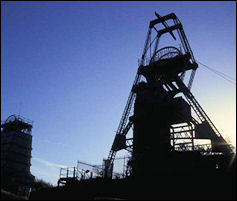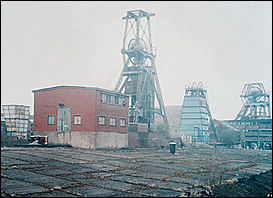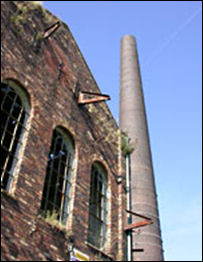|
It was a battle between brains and brawn, money men and
grafters. Margaret Thatcher and the Tory Government of the time were
insistent that coal mining in this country was uneconomic and
expensive and could be imported for less, and that deregulation of
financial markets would make everyone rich.
They were wrong, on both counts. Maybe the coal industry was
uneconomic at the time, but that was a short-term view, whilst
financial freedom has simply led to polarised communities, with the
rich getting richer and the poor getting poorer. On election in 1997,
Tony Blair vowed to eradicate poverty, but this has proved nigh on
impossible thanks to the untamed monster that Thatcher and her friends
created, allowing financial experts to create more ingenious ways to
make money. Maybe the pain that they are currently suffering is some
form of social justice.
Margaret Thatcher and her Government may have had valid points, and
ultimately an argument that could have been won. Deep down though,
she believed that the strike was unjustified, and it presented her
with an opportunity to flex her political muscles and hone her Iron
Lady image. And that she did.
However, what has caused most damage and hurt was the virtual
abandonment of coalfield communities that followed, communities that
were raised on coal, that relied on the industry for their living.
Told to “get on their bikes” to find new sources of employment, such
communities became alienated from mainstream life, with the now
recognised social ills of such public policy (drug and alcohol
abuse, health issues, housing problems) spiralling out of control.
Various Government-sponsored initiatives were developed to help
combat these problems, but the funds made available were mere
breadcrumbs. Former colliery sites were transformed into business
parks and new housing estates, and were trumpeted as the saviours of
coalfield communities.
However, many former colliers have not found new work on the revamped
pit sites, and very few mining families live in these new homes.
Indeed, coalfield areas continually come out at the top of lists of
the country’s most deprived communities. If there are any lessons to
be learned from regeneration programmes in such places, it is that
there must be more of a focus on the people that mined coal and their
families, rather than the sites and buildings.
Remnants of the mining industry in North Staffordshire are fast
disappearing. For example, Hem Heath colliery has been reclaimed and
is now a massive business park and the home of Stoke City Football
Club, Wolstanton Colliery is now a retail park that includes a 24
hour supermarket, and Norton Colliery is being transformed into a
huge soulless housing estate.
However, the Potteries possesses possibly the most complete former
colliery site in Europe in Chatterley Whitfield. Chatterley
Whitfield was one of the most productive mines in the country and
was the first colliery in Britain to achieve an annual output of
1million tons. The site is now a Scheduled Ancient Monument.
|

Chatterley Whitfield
The site lies around two miles north of Tunstall on the Potteries
coalfield, which is the largest in North Staffordshire. It is
considered that the Cistercian monks of Hulton Abbey may well have
extracted coal from Whitfield in the fourteenth century – there is
evidence to suggest that they mined coal from bell pits at nearby
Ridgway – but the first recorded workings on the site were by a
Burslem coal merchant in 1750. |
During the late eighteenth and early nineteenth centuries, the
site was developed as a colliery, and by the mid-1800s there was an
on-site engine house, wharf, carpenters shop, and brickworks.
In the 1850s, a prominent local businessman, Hugh Henshall Williamson,
expanded production, and after initially working ‘footrails’, he
subsequently sunk a number of shafts, including the Bellringer, the
Ten Foot, and the Engine Pit.
Further expansion of the mine followed the opening of the Biddulph
Valley Railway in 1860, and in 1865 a consortium of businessmen from
Tunstall acquired the colliery and went on to form the Whitfield
Colliery Company. In 1872, the managing director of the Chatterley
Coal and Iron Company, C. J. Homer, bought the site, and went on to
invest heavily in railway infrastructure.
However, this led to insolvency, and the company went into voluntary
liquidation in 1878. Production continued through an administrator
until 1890 when the business was acquired by a newly formed
Manchester-based company, the North of England Trustee Debenture and
Asset Corporation, who continued to own the site until the industry
was nationalised.
|


The Institute Shaft
The colliery suffered during the recession of the late 1920s and
early 1930s, but as the economy recovered in the years leading
up to the Second World War, the company invested heavily in the
new plant, workshops and railway equipment, and in 1939,
Chatterley Whitfield became the first colliery in Britain to
achieve an annual output of 1million tons of coal.
Following the Second World War, much modernisation occurred, and
in the early 1960s, ambitious plans were formulated to merge
Chatterley Whitfield with the nearby Norton and Victoria
collieries to create one ‘super colliery’ that – it was
envisaged – would have been capable of an annual production of
2million tons. However, this would have required significant
investment, and so the plan was never implemented.
Chatterley Whitfield ceased production on 25th March
1977, with the remaining seams worked from Wolstanton Colliery.
|
|

Platt Winding House and Chimney Stack
The following year, the now defunct Chatterley Whitfield Mining
Museum opened its doors to the public, with access to the
underground workings via the Winstanley Shaft, and at its peak,
attracted 40,000 visitors a year. Following the 1984-85 Miners’
Strike, the colliery at Wolstanton was closed, and this led to
fears that the Chatterley Whitfield workings would flood. As a
result, the National Coal Board invested £1million in the
construction of a simulated “underground experience” in former
railway cuttings south of the Institute Winding House.
In August 1993, the museum went into liquidation, and the site
reverted back to the City Council who owned the freehold. In
November of that year, the site was designated a Scheduled
Ancient Monument. It is also home to a host of Grade II and II*
Listed Buildings. |
|

Electrical and Mechanical Fitters Shop
The City Council have been working for a number of years to
restore the site, and bring it back into use, and in 2002, the
site was included in English Partnerships’ National Coalfields
Programme. Work on site is well underway, and an enterprise
centre has been opened, and civil engineering contractors Birse
are in the process of laying out a new country park.
Whilst the future for this former colliery seems bright, let’s
hope that the most important element of all coalfield
communities is not forgotten: the people. |
David Proudlove 13 Apr 2008 |
![]()
![]()
![]()
details on the Whitfield Listed Buildings